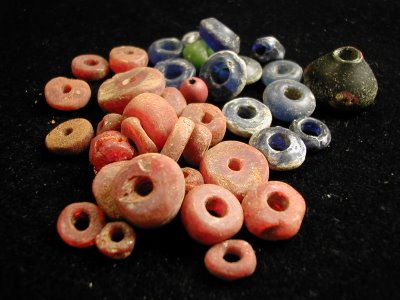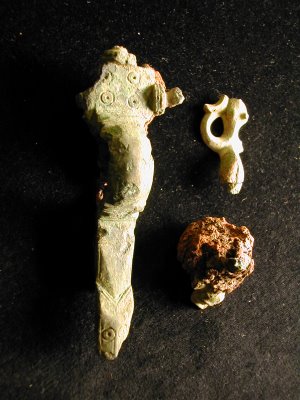Migration Period Chamber Graves
I've received an enjoyable commission, to write a pop-sci piece on the Danmarksby cemetery with my colleague Annika Westerholm. The cemetery was located just over ten kilometers from the great barrows of Old Uppsala, and was rescue-excavated in the 1970s. The E4 highway now runs straight over the spot.
Danmarksby is a funny name, meaning "Denmark's village". The place-name people have suggested that either it really has something to do with Danes or it means marshland. The latter idea seems to hold more weight at the moment. Hard to understand why a large village right next to the royal cult centre of the ancient Swedes would be named after the Danes. Permanent embassies were most likely unknown to the tribal societies of the late 1st millennium AD.
The cemetery hasn't received final write-up and so has been sort of a Flying Dutchman of Swedish Migration Period studies. This has less to do with the artefact finds, which are nice but not all that many, and more to do with the grave ritual. Out of a hundred excavated burials almost half were inhumations, which is extremely rare in 5th and early 6th century Sweden. A number of them were chamber burials, which adds to the excitement. Like all the other Migration Period chamber graves of the lake Mälaren area, these had been looted (or messily exhumed) shortly after burial, but there were a few nice bits and pieces left. Bone, however, was very poorly preserved.
This morning me and Annika went to the Museum of National Antiquities in Stockholm to photograph a selection of finds from Danmarksby. The excellent Kent Andersson welcomed us and made the stuff available to us in the study room. Good to see the place again, felt as if a shadow had lifted from it. The museum is getting back in gear after a few years of politically very correct and scientifically very weak direction. Great to see them hiring archaeology PhDs with lots of fieldwork experience! Hope the new boss doesn't mess it up again, whoever it turns out to be.


Grave 124 was an untouched non-chamber inhumation, no human bone preserved. The pix above show most of the beads -- amber and glass paste -- and two copper alloy brooches. The larger one is of a cruciform type common in southwestern Scandinavia. The smaller broken brooch is partly encased in organic remains but looks unique to me. The closest parallels I've seen are from Scania. Grave 124 also had a poorly preserved iron brooch and a belt knife.


Grave 17 was a chamber grave, 300 by 175 by 40 cm with corner posts. It had been looted and the contents messed up. Above is a pair of gilded silver clasp buttons with chip-carved spiral decoration and bits of a stamp-decorated pottery beaker. Migration Period pottery in the area is ugly as all hell, but this pot looks like it may have been imported from Gotland were good pottery is common. There's also a set of tweezers and resin caulking from a bark box.

This beautiful little silver Bügelknopf brooch was found in grave 141, an unassuming tiny concentration of burnt bone and charcoal. Other finds were just a copper alloy wire fragment and a few ugly potsherds. This is the oldest datable grave at the cemetery, a 4th century burial, and its general tinyness makes me wonder if it may have been a child's burial. The bones don't tell.
Great job, this. Pick out the best finds and most interesting structures from a site everyone's curious about and present it all to the interested public in an appealing way. I should try to find a way of getting paid to do this more often.
[More blog entries about Migration Period, Dark Ages, graves, archaeology, Sweden; folkvandringstiden, gravar, arkeologi, Uppland.]
Danmarksby is a funny name, meaning "Denmark's village". The place-name people have suggested that either it really has something to do with Danes or it means marshland. The latter idea seems to hold more weight at the moment. Hard to understand why a large village right next to the royal cult centre of the ancient Swedes would be named after the Danes. Permanent embassies were most likely unknown to the tribal societies of the late 1st millennium AD.
The cemetery hasn't received final write-up and so has been sort of a Flying Dutchman of Swedish Migration Period studies. This has less to do with the artefact finds, which are nice but not all that many, and more to do with the grave ritual. Out of a hundred excavated burials almost half were inhumations, which is extremely rare in 5th and early 6th century Sweden. A number of them were chamber burials, which adds to the excitement. Like all the other Migration Period chamber graves of the lake Mälaren area, these had been looted (or messily exhumed) shortly after burial, but there were a few nice bits and pieces left. Bone, however, was very poorly preserved.
This morning me and Annika went to the Museum of National Antiquities in Stockholm to photograph a selection of finds from Danmarksby. The excellent Kent Andersson welcomed us and made the stuff available to us in the study room. Good to see the place again, felt as if a shadow had lifted from it. The museum is getting back in gear after a few years of politically very correct and scientifically very weak direction. Great to see them hiring archaeology PhDs with lots of fieldwork experience! Hope the new boss doesn't mess it up again, whoever it turns out to be.


Grave 124 was an untouched non-chamber inhumation, no human bone preserved. The pix above show most of the beads -- amber and glass paste -- and two copper alloy brooches. The larger one is of a cruciform type common in southwestern Scandinavia. The smaller broken brooch is partly encased in organic remains but looks unique to me. The closest parallels I've seen are from Scania. Grave 124 also had a poorly preserved iron brooch and a belt knife.


Grave 17 was a chamber grave, 300 by 175 by 40 cm with corner posts. It had been looted and the contents messed up. Above is a pair of gilded silver clasp buttons with chip-carved spiral decoration and bits of a stamp-decorated pottery beaker. Migration Period pottery in the area is ugly as all hell, but this pot looks like it may have been imported from Gotland were good pottery is common. There's also a set of tweezers and resin caulking from a bark box.

This beautiful little silver Bügelknopf brooch was found in grave 141, an unassuming tiny concentration of burnt bone and charcoal. Other finds were just a copper alloy wire fragment and a few ugly potsherds. This is the oldest datable grave at the cemetery, a 4th century burial, and its general tinyness makes me wonder if it may have been a child's burial. The bones don't tell.
Great job, this. Pick out the best finds and most interesting structures from a site everyone's curious about and present it all to the interested public in an appealing way. I should try to find a way of getting paid to do this more often.
- Nockert, M. 1991. The Högom find and other Migration Period textiles and costumes in Scandinavia. Archaeology and environment 9. University of Umeå.
- Sigvallius, B. 1993. Danmarksby. Osteologisk undersökning av gravmaterialet från fornlämning 100, Danmarksby, Danmarks socken, Uppland. Dnr 4283/72. Rapportserie från Osteologiska enheten, Statens historiska museum 1993:11. Stockholm.
- [Wexell] Sjöberg, A. 1975. Två gravfält i Danmarks sn. Uppland 1975. Uppsala.
- Wexell, A. 1993. Danmarksby – en by redan under folkvandringstid? Långhundraleden. En seglats i tid och rum. Knivsta.
[More blog entries about Migration Period, Dark Ages, graves, archaeology, Sweden; folkvandringstiden, gravar, arkeologi, Uppland.]



0 Comments:
Post a Comment
<< Home